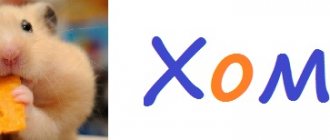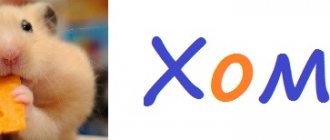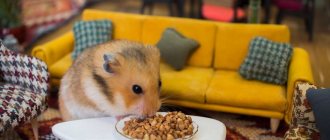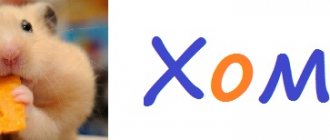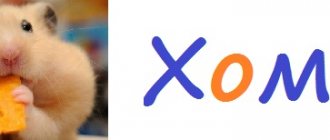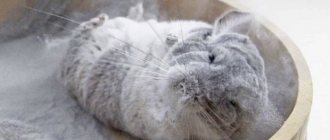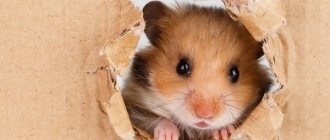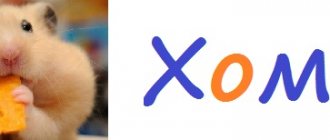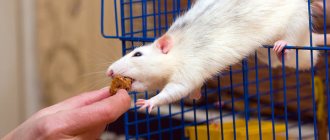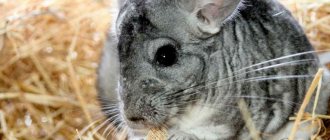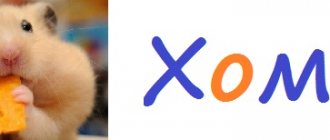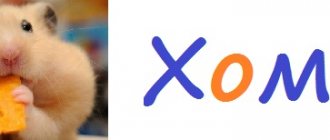- home
- Chinchilla
- Nutrition
04/03/2019 Chinchilla is a vegetarian by nature. She eats everything that the sparse but varied vegetation of her homeland, the highlands of the Andes, provides. In home-keeping conditions, owners try to choose the right products included in the animal’s diet. In addition to pellets and hay, the animals eat berries, dried vegetables and fruits, and gnaw twigs and twigs of trees and shrubs. Wanting to balance their pet's diet, owners are interested in whether chinchilla seeds are good for them.
There is no definite answer to the question, so you need to learn more about the different types of such delicacies and decide whether to introduce it to the rodent’s menu.
Benefits of pumpkin for rodents
In their natural habitat, hamsters love to eat not only grains, seeds and nuts. They enjoy searching for new food and nibbling on fresh plants, as well as fruits and vegetables. Among the latter is a rich list of fruits that can be fed to hamsters as their main food.
In the summer, seasonal vegetables appear in the diet of small pets. They contain important and necessary minerals, vitamins, and plant sugars.
These vegetables include raw pumpkin. Its juicy pulp copes well with thirst and is well suited as a treat for hamsters. It contains a complex of vitamins: B, C, E, PP. Rich in phosphorus, iron, potassium and protein.
Article on the topic: Can guinea pigs have cheese, milk and eggs?
Pumpkin fruit has a powerful antioxidant - beta-carotene. Experts recommend that everyone include it in the diet of hamsters for the following problems:
- Overweight;
- Diabetes;
- Problems with the gastrointestinal tract.
Pumpkin is a dietary product; its puree is also included in complementary foods even for small hamsters.
Can pumpkin be harmful?
Contains a large amount of fiber. It is not recommended for daily use by hamsters.
If you feed your hamster pumpkin more and more frequently, changes in the color of the rodent's coat may occur. So, for example, the fur of a white hamster will turn yellow, a cream hamster will turn orange, and a black hamster will turn brown.
How to give pumpkin correctly
The food we feed our favorite animals directly affects their well-being and appearance. Most often, when the owner wants to pamper his pet and treat him to “something tasty,” such delicacies are strictly contraindicated for hamsters.
It is allowed to carefully give your pet a taste of this or that vegetable in small portions and observe the reaction. However, hamsters are quite capable of digesting the pulp of fresh pumpkin.
For variety, furry rodents can periodically include raw or processed pumpkin in their diet. One option is to give hamsters stewed, steamed or boiled pumpkin.
The first step is to wash the product well. Then serve it like this or heat treat it. When you bring a purchased pumpkin from the store, you should definitely wash it well, and it is best to remove the peel in a very thick layer.
It is necessary to cut the peeled flesh into small pieces to make it easier and more convenient for the hamster to eat them. Also, it is important to promptly remove uneaten leftovers from the cage, otherwise they will begin to rot, and the animals should eat only fresh food.
Canned vegetables are never suitable for feeding your furry friend!
Article on the topic: The best food for chinchillas: composition, description, rating
The best quality vegetable is always the one that was grown in its own garden, without treatment with pesticides.
The right diet for a chinchilla
Experts in breeding rodents of this species recommend using granulated food. A half-kilogram package of food for an adult animal will last for a month and a half. After opening the pack, you need to move its contents into a container that has an airtight lid. This way the food will be kept fresh without losing its beneficial properties.
Pelleted food is beneficial due to its similarity to animal food in the natural environment. It contains a high amount of grains, herbs and vegetables.
The positive side of granular food is its hard consistency, thanks to which the animal can wear down its teeth while eating food.
An essential component in a chinchilla's home is hay. For the comfort of the pet, a special hay mat is used, which can be purchased at a pet store. The total amount of hay should not be more than pellets. Such a nutritional supplement for animals, in principle, can be prepared personally by the owner, but experts recommend using products from pet stores. The bottom line is that most grass is unsuitable for chinchillas to eat. A pet can get poisoned and have problems with the digestive system.
Is it possible to give pumpkin seeds to a hamster?
Pumpkin seeds are considered a healthy product. They are added to ready-made grain mixtures for hamsters. If you choose your own menu for your pet, don’t forget to add these seeds. Your little animal will undoubtedly not mind eating them.
Pumpkin seeds in a hamster's diet will help get rid of helminths - the substance contained - cucurbitin - has an anthelmintic effect. Protein, fat, vitamins A, E, B, phosphorus, zinc, potassium and magnesium - all this is part of pumpkin seeds.
It is worth remembering that seeds for hamsters should be raw, peeled, without salt and spices.
The benefits of pumpkin in the diet of small rodents are obvious. You can include the product in your pet’s menu, but you still don’t need to give it constantly. With variety in the diet, the hamster will receive the necessary vitamins and will enjoy eating it with pleasure.
Main menu
The chinchilla diet includes hay and twig food, grain mixture, vegetables, fruits, and berries. The animals are given greens and nuts as a healthy and tasty supplement.
To enrich the menu with vitamins and microelements, pets are given complex water-soluble vitamins: Beafar, Vita-Sol, Canina Petvital. The drugs are added to food or water according to the instructions.
Rough and juicy food
Rough feed includes hay and tree branches. This is the basis of the diet of a rodent, whose digestive tract is designed to digest food rich in fiber. Herbal granules contained in ready-made food for chinchillas cannot fully satisfy the animal's need for fiber.
Juicy food (vegetables, fruits, fresh herbs) are sources of vitamins and microelements for the animal’s body. You can feed your chinchilla the following foods:
- pumpkin, carrots, zucchini, cucumbers, root parsley, celery;
- apples, pears, melon, watermelon, seedless grapes, plums, bananas;
- berries of rowan, hawthorn, viburnum, rose hips, barberry;
- dried meadow grass, tops of legume garden plants, leaves of dandelion, honey, nettle and quinoa.
Combined feeds
Purchasing ready-made specialized mixtures greatly simplifies the care of feeding animals. The compound feed recipe is developed by scientists specifically for different groups of animals - young animals, pregnant and lactating females, adults. The composition meets the needs of the chinchilla and is balanced in the amount of proteins and fats.
In addition to ready-made food, the pet must be provided with hay. Occasionally you can pamper the animal with a treat.
At home, chinchillas happily eat food from the following brands: Little On, Waka, Vitacraft, Versel-Laga. Preference should be given to granulated food, from which the pet will not be able to choose the most delicious pieces, ignoring the rest of the food.
Vitacraft
Little He
Waka
Vercelles-Laga
Prohibited Products
Persimmons are prohibited for feeding. This fruit, useful for humans, is rich in iodine, which is contraindicated for animals. In addition to iodine, persimmons contain a lot of sugar and astringents, which will lead to constipation.
It is not recommended to give chinchillas and beets.
The root vegetable is healthy, but has a laxative effect. In rare cases, small pieces of beets can be given for constipation. Any type of cabbage leads to severe gas formation. Chinchillas love to feast on tea rose petals - they taste pleasant and have an attractive aroma. If flowers are grown in your own garden, there is no danger, but it is better not to give store-bought ones. They contain a lot of pesticides and chemicals that can cause serious poisoning.
Article on the topic: What branches can be given to a chinchilla (trees)
When preparing tree branches for the winter, it is worth remembering which species are dangerous and unsuitable for feeding. Branches of which trees cannot be harvested:
- Apricot,
- white acacia,
- Beech,
- Ash leaf maple,
- Common buckthorn
- Cedar,
- Chestnut,
- Branches of any citrus species,
- Cypress,
- Elderberries,
- Cherries,
- Cherries,
- Branches of any coniferous species,
- Holly,
- Hydrangeas,
- Juniper,
- Common maple
- Myrta,
- Oleander,
- Plums.
Oak bark and twigs can only be given to animals suffering from diarrhea. In healthy animals they cause severe constipation.
Branches of stone fruit trees (cherry, cherry, plum, and so on) are dangerous because they contain a dangerous cyanide compound, as a result of the breakdown of which hydrocyanic acid is formed in the chinchilla’s body. If you feed an animal with such twigs, you can get not only severe poisoning, but also the rapid death of your pet.
Prohibited products also include any type of honey, as well as store-bought cottage cheese and fermented milk products.
Not all breeders know that chinchillas should not be given leaves, stems and flowers of indoor plants. Most of them are poisonous to the animal and very often cause death.
It is also not recommended to give any food from a person's table. Everything that is normal and familiar, even useful for people, for a chinchilla becomes the cause of digestive problems, allergies, obesity and other serious diseases. The animal will never refuse tasty and aromatic food and can eat a piece of cake, cheese, meat or fish. However, such food is not normal and familiar to the stomach of a furry pet. And the possible consequences are very sad.
Menu of a pregnant female
A pregnant chinchilla may eat a little more than usual. This is normal, but you should not overfeed her, otherwise the female’s health will suffer greatly from obesity. Nutrition during this period changes slightly. Veterinarians advise including in the diet of chinchillas:
- sprouted grain;
- food of animal origin (eggs, milk, cottage cheese);
- more protein due to an increase in the proportion of grains;
- apple;
- bee bread 1-2 balls per day;
- alfalfa, strawberry leaves, calendula flowers;
- rosehip, hawthorn;
- flax seeds;
- cereals;
- vitamins and mineral supplements;
- calcium: a quarter tablet of calcium gluconate or 1 tablet of Excel Calcium per day.
Calcium deficiency is dangerous for pregnant females: it causes eclampsia, which without treatment leads to the death of the animal. You need to exclude mint, thyme and lemon balm from your diet.
Foods that can be given in limited quantities
Many breeders argue about the need or possibility of feeding these types of products to the animal. However, in small quantities they bring more benefits.
Article on the topic: The importance of water in the life of a chinchilla
The first such product is nuts. Chinchillas simply love them. Nuts contain many useful microelements, vitamins, acids and amino acids. The danger is that nuts can cause allergies, diarrhea and provoke the development of obesity. However, once a week you can offer your pet a tasty treat - walnuts, almonds, peanuts or hazelnuts. The main thing is that there should only be one nut.
A lot of controversy arises about seeds. They contain a large amount of fatty acids, and those who are involved in breeding and exhibitions know what a positive effect the seeds have on the condition of the fur and the appearance of the animal. However, an excess of seeds in the diet can lead to obesity and problems with the stomach. Chinchillas can be given some pumpkin or watermelon, sunflower or flax seeds. It is very important to remember that the seeds must be fresh. Roasted pumpkin or sunflower seeds will cause constipation and poisoning.
Dried fruits are most often used as a treat. If you really want to treat your animal to a piece of raisins or dried apricots, give it no more than once a week and only in small quantities.
Any type of dried fruit has a number of very useful substances for humans, but they are not entirely suitable for chinchillas. Raisins are too sweet and can cause problems with your sugar levels. Most often, raisins are given to sick animals that refuse to eat or to a female who has just given birth. Prunes have a strong laxative effect and you can only give a small piece if you are constipated.
It is better not to give candied fruits and berries - animals eat them with great joy, but such products contain too much sugar and too few useful components. You can treat your pet with canned pineapples or papaya. However, it is better to avoid such experiments. The chinchilla's intestines are very delicate and no one can predict in advance about the reaction to a new type of treat.
Article on the topic: Can chinchillas eat nuts (walnuts, pine nuts and others)
Breeders also argue about the acceptability of feeding crackers. It is not recommended to give fresh bread to animals - it often leads to the formation of gases, but fresh crackers, especially from yeast-free bread, can be a good treat.
Apple seeds
The diet of herbivores, such as chinchillas, includes fruits. One of the favorite foods of rodents is apples. They are offered to animals in a dried or dried form so as not to cause digestive upset.
There is no need to peel the core of these fruits. If an animal eats a few small seeds from it along with a piece of apple, nothing bad will happen. Recent studies suggest that apple seeds contain substances that can prevent cancer. As a preventive measure, a person is recommended to consume 4-5 seeds daily.
Chinchillas only need a few seeds eaten with an apple. You should not store them specifically and offer them to animals as a separate dish.
Authorized Products
The list of foods that can be given to chinchillas is quite large. Animals can be fed fruits:
- Bananas,
- Apples,
- Pears,
- Figs
- Vegetables:
- Pumpkin,
- Milk corn,
- Bell pepper,
- Kohlrabi,
- Zucchini,
- Zucchini,
- Kohlrabi,
- Patissons,
- Ripe red tomatoes.
Greenery:
- Lettuce leaves,
- spinach leaves,
- Clover,
- Alfalfa,
- sorrel leaves,
- Dandelion leaves and stems,
- Celery,
- Chicory,
- Cornflowers,
- Vika,
- Common nettle,
- Sagebrush,
- Raspberry leaves and stems
- Strawberry leaves and stems
- Plant tops,
- Twigs with leaves of apple, pear,
- Birch and linden branches,
- Hazelnut sprigs.
- Corn (corn grains are part of the feed mixture and are given in ground form),
- Barley (given in ground form),
- Wheat (grains and bran),
- Oats (grains, bran, flakes),
- Millet,
- Buckwheat,
- Rice.
- Soybean,
- Peas,
- Beans,
- Red and white beans,
- Lentils.
Apples, pears, as well as carrots, pumpkins, zucchini, berries can be given to animals both fresh and dried.
Some chinchillas are more willing to eat dried foods, and they are also safer for the digestive tract.
It is recommended to collect fresh grass for furry pets in places far from roads and landfills, walking pets and industrial enterprises. It is not recommended to feed grass that is wet from dew or rain. And also carefully monitor that there are no poisonous plants among other weeds.
Feeding recommendations
When organizing food, it is not enough to know what you can feed a chinchilla and what you cannot feed. Proper feeding also means following a diet, keeping feeders and drinkers clean, as well as understanding the peculiarities of the animal’s digestion. The first and most important rule is that there should always be hay in the cage, as well as drinking water. Feeders and drinkers must be clean. To do this, they must be disinfected regularly (at least twice a week) with boiling water. It is better not to use wooden feeders - they absorb odors and become sources of mold and mildew. Preference should be given to ceramic ones, which attach well to the cage and are easy to clean.
Article on the topic: Is it possible to give chinchillas fresh grass, dandelions, clover, etc.
Chlorhexidine can be a disinfectant for the entire cage - it kills germs well and is odorless, but it is better not to use it for drinkers and feeders. Some breeders use regular laundry soap as a disinfectant. You can also wipe the drinking bowls and feeders, as well as the cage, with alcohol. It is also necessary to keep the cage clean because sometimes the animal prefers to eat on the rest area or even in the house. Many owners have noticed how a chinchilla takes a piece of food and runs for cover.
It is also important to ensure that all feed is fresh, clean, and free of dust, rot, and mold. It is recommended to buy ready-made food only from trusted pet stores. All succulent food, as well as lettuce or spinach, must be washed well before being given to the animal. Branches and bark of trees that are offered to your pet must be well dried and free of traces of insect activity.
Vegetables and fruits intended for chinchillas must be washed and cut into convenient small pieces.
It is necessary to feed your pet at the same time, and all leftover food is removed from the feeder the next day. It is most preferable to feed roughage in the evening, and succulent feed in the morning. If the chinchilla is reluctant to eat, you should change the food. The first reason for poor appetite is monotonous food. New types of feed should be introduced gradually and little by little. If you are not sure whether chinchillas can eat this or that type of product, it is better to abandon it altogether and add something that the animal has already tried and eats with pleasure.
Sunflower grains
Animals living in a house or apartment lose their survival skills in nature. Therefore, it is a big mistake to hope that the animals know on their own what they can eat and what they cannot. And if you give your chinchilla roasted seeds, she will eat them with pleasure. However, you don’t need to follow your pet’s lead! Experts note that chinchillas are not recommended to consume sunflower seeds.
Roasted seeds are especially harmful to rodents. Since rodents simply cannot find such food in their natural environment, their digestive system is not adapted to this food. You can give the seeds raw, but in limited quantities. Raw sunflower seeds contain a large amount of fatty acid, which has a positive effect on the chinchilla's coat. Due to the high level of fat content of this product, the animal may develop indigestion. There is a high risk of constipation and intestinal infections, as well as the development of obesity, so you should not feed your pet seeds often.
How to eat seeds without harming your health
August 8, 2022 at 10:56 Elena Slobodyan, Arguments and facts in Belarus
Article on the topic: The importance of water in the life of a chinchilla
Some believe that raw seeds are better than roasted ones: they are healthier and not as high in calories. Others, on the contrary, claim that roasted seeds are not only tastier, but also safer for health. “AiF” found out from a nutritionist whether eating raw seeds can be harmful to health and who needs to use this product with caution.
Photo: pixabay.com
“You can eat a small handful of seeds, but it all depends on the overall caloric content of the diet. Many people believe that they eat practically nothing, but then it turns out that a person might not have eaten anything at lunch, but at the same time ate half a glass of seeds while talking on the phone or while watching a movie. This is not taken into account, since many people believe that seeds are not food at all. But in fact, this is food, and very, very high in calories. In fact, the calorie content of seeds is the same as butter. And in terms of calories, it makes no difference whether they are raw or fried. Roasting seeds is not recommended at all. They are useful because they contain vegetable oil, unsaturated fatty acids, various trace elements, vitamin E, etc. But unsaturated fatty acids oxidize too quickly, and at high temperatures they form carcinogenic substances that have a negative effect on cells human body,” says nutritionist Elena Solomatina .
What chinchillas shouldn't do
Although rodents are supposed to eat fruits, some can be harmful to their health.
It is strictly forbidden to give to animals:
And the seeds of these berries are completely prohibited. They contain hydrocyanic acid, which is poisonous.
Important! Never feed berry seeds to animals, even if they happily eat them.
Experts believe that chestnut fruits and nuts are also harmful to rodents. Although many manufacturers add nuts to the feed. But these “goodies” are a big burden on the animal’s liver.
How are raw seeds beneficial and how can they be harmful?
The most popular sunflower seeds are 80% fat, most of which is unsaturated. Fats are the main light source of energy, but if there is nowhere to spend it, then fat deposits form in the body. It is also worth noting the high calorie content of sunflower seeds: 580 calories per 100 g. Therefore, the product should be consumed with extreme caution, as it contributes to the formation of excess weight, warns the nutritionist. Unlike raw ones, roasted sunflower seeds lose the bulk of their beneficial components and serve only as a source of “empty” calories.
Article on the topic: What branches can be given to a chinchilla (trees)
Pumpkin seeds contain a large amount of vitamins, amino acids and other nutrients. But, like sunflower seeds, they are considered a very high-calorie product. It is recommended to eat no more than 60-100 g of seeds per day.
Raw pumpkin seeds should be consumed with caution by those who have increased stomach acidity and exacerbation of gastrointestinal diseases, as well as by allergy sufferers. Pumpkin allergies are rare, but cross-reactions between allergens from pumpkin, pumpkin seeds, melon, watermelon, cucumber and squash are possible. Therefore, patients with severe allergic diseases should consume raw pumpkin seeds with caution. If you have an allergy or intolerance, you may experience symptoms such as difficulty inhaling and/or exhaling, a feeling of lack of air, dizziness, swelling and congestion of the nasal mucosa, sore throat, and repeated non-stop sneezing.
What other health problems can consuming raw seeds lead to?
Allergies can also be caused by eating seeds of poor quality. Treating them with dyes, chemicals and preservatives to preserve the presentation of the product can contribute to the development of an allergic reaction. Molds can also cause a reaction: this is a strong allergen, they can be present in seeds that were stored incorrectly.
“You can eat pumpkin and sunflower seeds raw; they do not contain anything poisonous. But the whole point is where such seeds were stored. Raw seeds are more susceptible to various mold processes, and pathogenic microflora also develop faster in them. And, in fact, because of this, it is dangerous to consume raw seeds. If it’s an absolutely fresh product, then go ahead, but if you don’t know where, how and how long they were stored, then it’s better not to eat them,” says Solomatina.
“Clicking” seeds is not very beneficial for tooth enamel. Although peeled seeds are safer for teeth, they do not have much value for the body. When exposed to air, the fats contained in them quickly oxidize and lose their beneficial qualities. The nutritionist advises buying seeds only in the peel and peeling them yourself, and drying them a little before use, but not frying them.
Article on the topic: Is it possible to give chinchillas fresh grass, dandelions, clover, etc.
List of "Do's and Don'ts"
Re: List of "Do's and Don'ts"
Message number: #161 Ivanovna » Sat Jun 25, 2011 13:13
If you do not want to see this block, register or log in under your name.
Re: List of "Do's and Don'ts"
Message number: #162 Marina Lepel » Sat Jun 25, 2011 14:25
Re: List of "Do's and Don'ts"
Message number: #163 Ivanovna » Sat Jun 25, 2011 14:36
Re: List of "Do's and Don'ts"
Message number: #164 lavina » Sun Jun 26, 2011 15:56
vice versa! Thank you very much for your complete and detailed answer!
By the way, the other day I bought additional food (I don’t even know how to translate it correctly) for chinchillas, it’s called “flower field”. So it contains sunflower petals and marigolds. Moreover, marigolds are already just boxes with seeds. mine just attacked them first
Re: List of "Do's and Don'ts"
Message number: #165 Love » Tue Jul 05, 2011 18:56
Re: List of "Do's and Don'ts"
Message number: #166 koda » Tue Jul 05, 2011 20:46
Re: List of "Do's and Don'ts"
Message number: #167 Passerby » Tue Jul 05, 2011 22:42
I’ve never given them one yet (I just can’t get around to buying them especially for Nyusha), but for myself (as a result of scouring various chinchilla sites) I came to the same conclusion as koda - no more than two medium or one large sunflower seeds per week. I think that (despite the undeniable abundance of useful substances) they should not be abused due to the significant amount of oil they contain.
By the way, I wanted to ask one more question in connection with pumpkin seeds. It is generally accepted that they are a good prophylactic anthelmintic (anthelminthic) agent. But then I came across an indication that pumpkin seeds are used “against various tapeworms” [emphasis added]. This is where the question came to me. I know that, in general, the variety of helminths is not limited only to tapeworms, but what kind of helminths are found in hornets and can hornworms have tapeworms? Or maybe the anthelmintic properties of these seeds are no more important for our jokers than a strong lock on the display case doors?
